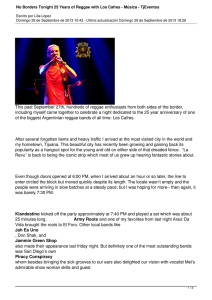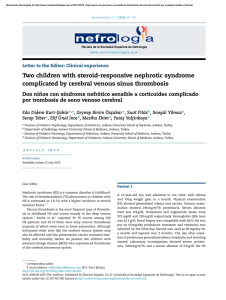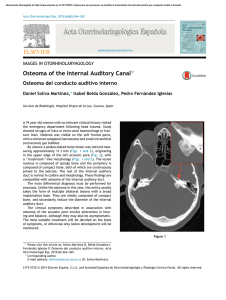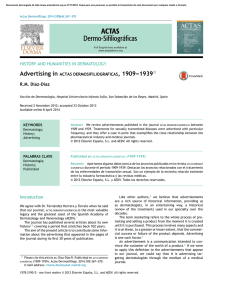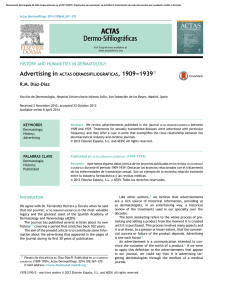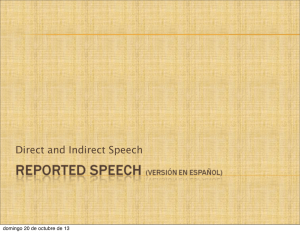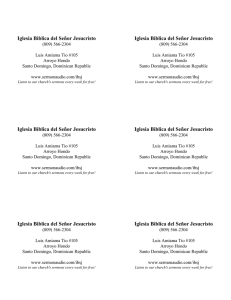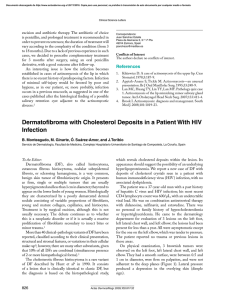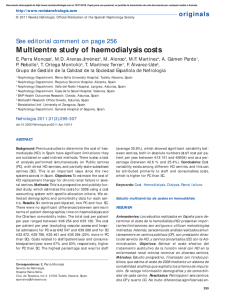To my friend Domingo Saénz Benito
Anuncio
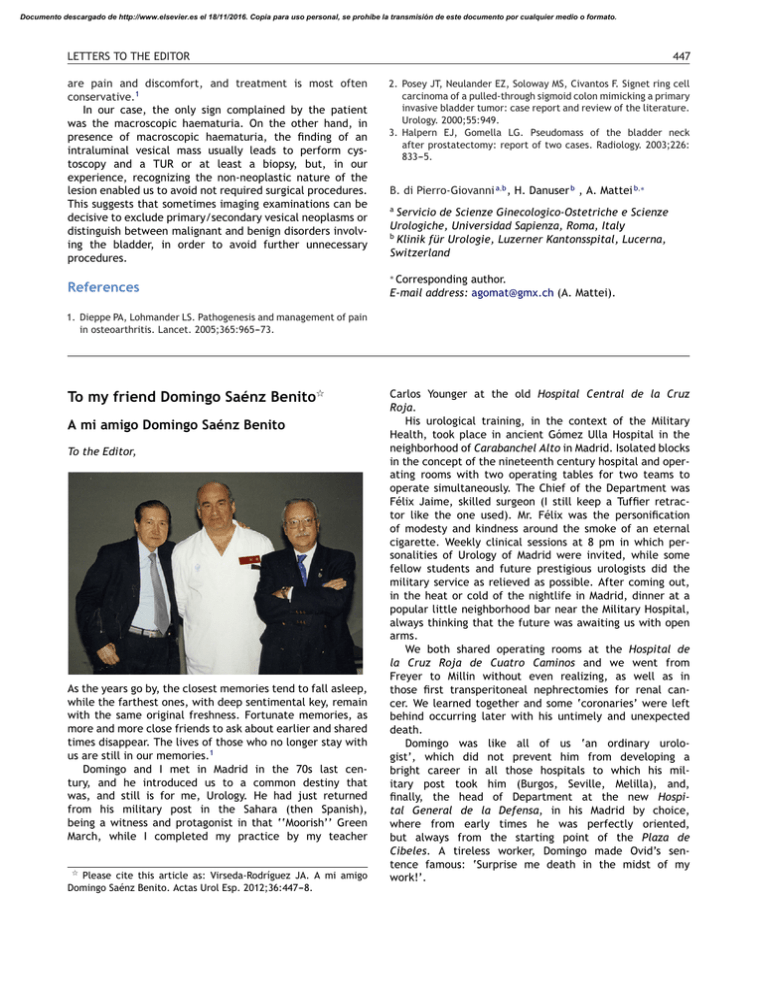
Documento descargado de http://www.elsevier.es el 18/11/2016. Copia para uso personal, se prohíbe la transmisión de este documento por cualquier medio o formato. LETTERS TO THE EDITOR are pain and discomfort, and treatment is most often conservative.1 In our case, the only sign complained by the patient was the macroscopic haematuria. On the other hand, in presence of macroscopic haematuria, the finding of an intraluminal vesical mass usually leads to perform cystoscopy and a TUR or at least a biopsy, but, in our experience, recognizing the non-neoplastic nature of the lesion enabled us to avoid not required surgical procedures. This suggests that sometimes imaging examinations can be decisive to exclude primary/secondary vesical neoplasms or distinguish between malignant and benign disorders involving the bladder, in order to avoid further unnecessary procedures. 447 2. Posey JT, Neulander EZ, Soloway MS, Civantos F. Signet ring cell carcinoma of a pulled-through sigmoid colon mimicking a primary invasive bladder tumor: case report and review of the literature. Urology. 2000;55:949. 3. Halpern EJ, Gomella LG. Pseudomass of the bladder neck after prostatectomy: report of two cases. Radiology. 2003;226: 833---5. B. di Pierro-Giovanni a,b , H. Danuser b , A. Mattei b,∗ a Servicio de Scienze Ginecologico-Ostetriche e Scienze Urologiche, Universidad Sapienza, Roma, Italy b Klinik für Urologie, Luzerner Kantonsspital, Lucerna, Switzerland Corresponding author. E-mail address: [email protected] (A. Mattei). ∗ References 1. Dieppe PA, Lohmander LS. Pathogenesis and management of pain in osteoarthritis. Lancet. 2005;365:965---73. To my friend Domingo Saénz Benito夽 A mi amigo Domingo Saénz Benito To the Editor, As the years go by, the closest memories tend to fall asleep, while the farthest ones, with deep sentimental key, remain with the same original freshness. Fortunate memories, as more and more close friends to ask about earlier and shared times disappear. The lives of those who no longer stay with us are still in our memories.1 Domingo and I met in Madrid in the 70s last century, and he introduced us to a common destiny that was, and still is for me, Urology. He had just returned from his military post in the Sahara (then Spanish), being a witness and protagonist in that ‘‘Moorish’’ Green March, while I completed my practice by my teacher 夽 Please cite this article as: Virseda-Rodríguez JA. A mi amigo Domingo Saénz Benito. Actas Urol Esp. 2012;36:447---8. Carlos Younger at the old Hospital Central de la Cruz Roja. His urological training, in the context of the Military Health, took place in ancient Gómez Ulla Hospital in the neighborhood of Carabanchel Alto in Madrid. Isolated blocks in the concept of the nineteenth century hospital and operating rooms with two operating tables for two teams to operate simultaneously. The Chief of the Department was Félix Jaime, skilled surgeon (I still keep a Tuffier retractor like the one used). Mr. Félix was the personification of modesty and kindness around the smoke of an eternal cigarette. Weekly clinical sessions at 8 pm in which personalities of Urology of Madrid were invited, while some fellow students and future prestigious urologists did the military service as relieved as possible. After coming out, in the heat or cold of the nightlife in Madrid, dinner at a popular little neighborhood bar near the Military Hospital, always thinking that the future was awaiting us with open arms. We both shared operating rooms at the Hospital de la Cruz Roja de Cuatro Caminos and we went from Freyer to Millin without even realizing, as well as in those first transperitoneal nephrectomies for renal cancer. We learned together and some ‘coronaries’ were left behind occurring later with his untimely and unexpected death. Domingo was like all of us ‘an ordinary urologist’, which did not prevent him from developing a bright career in all those hospitals to which his military post took him (Burgos, Seville, Melilla), and, finally, the head of Department at the new Hospital General de la Defensa, in his Madrid by choice, where from early times he was perfectly oriented, but always from the starting point of the Plaza de Cibeles. A tireless worker, Domingo made Ovid’s sentence famous: ‘Surprise me death in the midst of my work!’. Documento descargado de http://www.elsevier.es el 18/11/2016. Copia para uso personal, se prohíbe la transmisión de este documento por cualquier medio o formato. 448 In recent times, the acquisition of a small retreat at the Vera in Caceres allowed him to rest with his family. There, he was the friend and ‘GP’ of all with whom he shared affection and respect. But, undoubtedly, his best creation were his sons Luis Domingo, Ana María, and Cristina on the way of love with his wife Milagros, whom he adored, being an excellent husband and a better father. So, when you live in the hearts we leave behind us, that is not dying. It all ends so that everything starts again on the good seeds sown. The nobility of his native Logroño and the honesty of his character made him be loved and remembered by his many patients, and especially friends including among them our current President of the AEU, Humberto Villavicencio, from the lecture rooms they shared at the close Faculty of Medicine of Zaragoza and the Colegio Mayor de los Carmelitas, and whom he considered a brother. LETTERS TO THE EDITOR Nothing seems better to me than saying goodbye to Domingo from these lands of La Mancha, still hosting the mortal remains of Jorge Manrique and his sensed verse: ‘We depart at birth, /we walk while living/, and we arrive/when we expire; /so when we die/ we rest’. Reference 1. Angulo JC. Respuesta del Director: Adiós a otros colegas y amigos desaparecidos. Actas Urol Esp. 2011;35:251. J.A. Virseda-Rodríguez Hospital Universitario de Albacete, Facultad de Medicina, Universidad de Castilla-La Mancha, Albacete, Spain E-mail address: [email protected]


